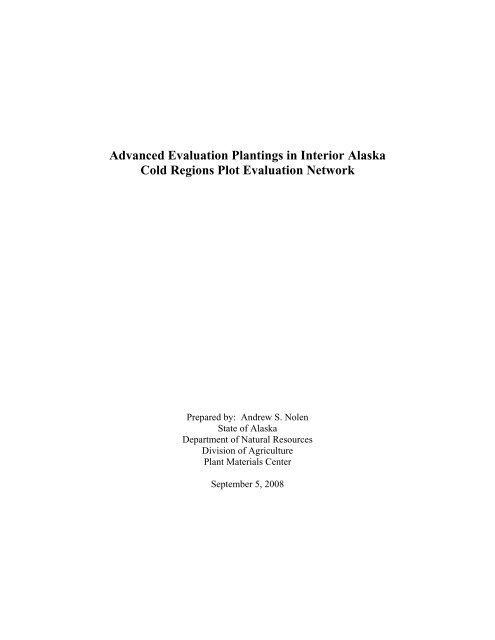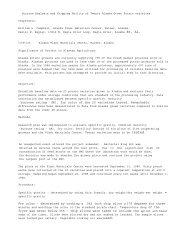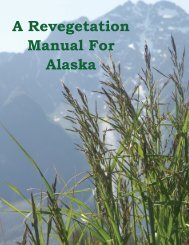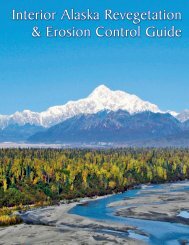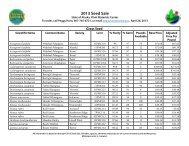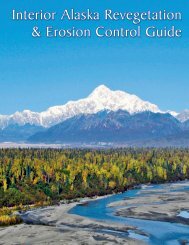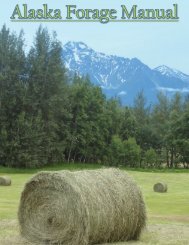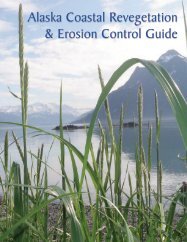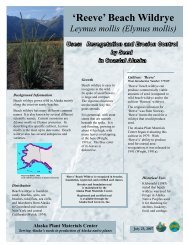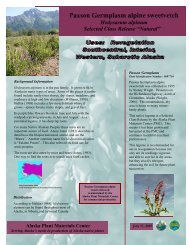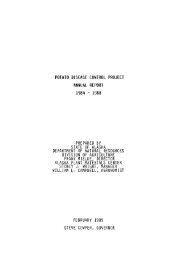Advanced evaluation plantings in Interior Alaska - Cold regions plot ...
Advanced evaluation plantings in Interior Alaska - Cold regions plot ...
Advanced evaluation plantings in Interior Alaska - Cold regions plot ...
You also want an ePaper? Increase the reach of your titles
YUMPU automatically turns print PDFs into web optimized ePapers that Google loves.
<strong>Advanced</strong> Evaluation Plant<strong>in</strong>gs <strong>in</strong> <strong>Interior</strong> <strong>Alaska</strong><strong>Cold</strong> Regions Plot Evaluation NetworkPrepared by: Andrew S. NolenState of <strong>Alaska</strong>Department of Natural ResourcesDivision of AgriculturePlant Materials CenterSeptember 5, 2008
Introduction:<strong>Advanced</strong> <strong>evaluation</strong> <strong>plant<strong>in</strong>gs</strong> are established to evaluate the performance of accessionsthat have previously performed well <strong>in</strong> <strong>in</strong>itial <strong>evaluation</strong> <strong>plant<strong>in</strong>gs</strong>. These <strong>plant<strong>in</strong>gs</strong> aid <strong>in</strong>the development of new varieties for many end uses. The <strong>plant<strong>in</strong>gs</strong> also allowcomparisons of new plant material with varieties that have been traditionally used. Plantmaterial with potential for forage, turf and conservation uses were selected for plant<strong>in</strong>g <strong>in</strong>several <strong>Interior</strong> <strong>Alaska</strong> locations. Plots were planted near Fairbanks and Seven MileCamp <strong>in</strong> 2003 and evaluated through 2007. Plots near McGrath and Delta Junction wereplanted <strong>in</strong> 2004 and evaluated through 2007.Project History:The <strong>Alaska</strong> Plant Materials Center (PMC) has established advanced <strong>evaluation</strong> <strong>plant<strong>in</strong>gs</strong>throughout its history as part of the mission of develop<strong>in</strong>g plant material for differentuses with<strong>in</strong> <strong>Alaska</strong>. This particular effort was conducted as part of the larger <strong>Cold</strong>Regions Project funded by a grant from the United States Department of Agriculture,Natural Resource Conservation Service.Plot Layout:The <strong>in</strong>itial effort on this project was to develop the <strong>plot</strong> layout which consisted ofaccessions with varied end uses. Native species suitable for conservation was one of theprimary focuses though <strong>in</strong>put from small scale agricultural producers from around theregion encouraged the <strong>in</strong>clusion of forage crops for <strong>evaluation</strong>. Turf varieties were also<strong>in</strong>cluded along with some native wild flowers. Table 1 presents the typical <strong>plot</strong> layout.Each accession was planted <strong>in</strong> 4 foot by ten foot block at a rate of 40 pounds per acre.Seed was raked <strong>in</strong> by hand to <strong>in</strong>corporate at an approximate depth of ¼ <strong>in</strong>ch. Varietieswith similar end uses were planted adjacent to one another to allow for bettercomparison. Each <strong>plot</strong> was fertilized with one application of 20-20-10 follow<strong>in</strong>gplant<strong>in</strong>g. Two blocks of ‘Boreal’ red fescue were planted to result <strong>in</strong> an even number ofblocks.
Table 1. Typical Plot Layout‘Park’ Kentucky Bluegrass‘Alene’ Kentucky Bluegrass‘Nugget’ Kentucky Bluegrass‘Tundra’ Glaucous Bluegrass‘Service’ Big Bluegrass‘Norcoast’ Ber<strong>in</strong>g Hairgrass‘Durar’ Hard Fescue‘Nortran’ Tufted Hairgrass‘Arctared’ Red Fescue‘Boreal’ Red Fescue‘Pennlawn’ Red Fescue‘Boreal’ Red Fescue‘Gruen<strong>in</strong>g’ Alp<strong>in</strong>e Bluegrass‘Andrew Bay’ Large-glume Bluegrass‘N<strong>in</strong>ilchik’ Pucc<strong>in</strong>ellia nutkaensis ‘Egan’ American Sloughgrass‘Alyeska’ PolargrassMeadow Foxtail (Common)‘Sourdough’ Bluejo<strong>in</strong>t‘Caiggluk’ Tilesius Sage‘Hannas High Tech’ Alfalfa‘Beaver’ Alfalfa‘James’ Dahurian Wild RyePI 345600 Siberian Wild RyeAltai Wild Rye (Common)Russian Wild Rye (Common)‘Kirk’ Crested WheatgrassSlender Wheatgrass (Common)‘Wa<strong>in</strong>wright’ Slender Wheatgrass ‘Chief’ Intermediate Wheatgrass‘Manchar’ Smooth Brome‘Carlton’ Smooth Brome‘Climax’ Timothy‘Engmo’ Timothy‘Farol’ Timothy‘Alma’ TimothySome additional accessions were <strong>in</strong>cluded at the McGrath and Delta Junction locationsbecause they were planted at a later time when more plant material had been added to the<strong>plot</strong> layout. These additional accessions <strong>in</strong>cluded:‘Kenai’ Polargrass‘Port Clarence’ large flower speargrass‘Polar’ Brome‘Solomon’ Thick Spike Wheatgrass‘Max Q’ Tall Fescue‘Lodorm’ Needlegrass‘Paxson’ Hedysarum alp<strong>in</strong>um‘Casco Cove’ Beach Lovage‘K<strong>in</strong>g Salmon’ Golden Rod‘Clam Lagoon’ Beach FleabaneNootka Lup<strong>in</strong>e (Common)‘Tok’ Jakutsk Snow Parsley‘Shemya’ Dusty Miller‘Kotzebue’ Arctic ChamomilePolemonium acutiflorum‘Denali’ AlfalfaThe seed needed for the advance <strong>evaluation</strong> <strong>plant<strong>in</strong>gs</strong> were acquired from exist<strong>in</strong>g PMCseed stocks, <strong>Alaska</strong> Mill and Feed, and Hannas Seeds.Plot Locations and Preparation:The <strong>plot</strong>s were replicated at sites around the region <strong>in</strong>clud<strong>in</strong>g Fairbanks, McGrath, DeltaJunction, and Seven Mile Camp. Cooperators <strong>in</strong>clud<strong>in</strong>g The Project Inc., Malone Farms,Olberg Farms, and the Department of Transportation (DOT) aided <strong>in</strong> the project byprovid<strong>in</strong>g land for the <strong>plot</strong>s as well as ground preparation. The soil at each <strong>plot</strong> locationwas prepared by remov<strong>in</strong>g exist<strong>in</strong>g vegetation if present by cultivation or blad<strong>in</strong>g with adozer or loader.The Fairbanks <strong>plot</strong> was established at The Project Inc. farm <strong>in</strong> the Eielson Farm Looparea <strong>in</strong> a waste area on the corner of the property with the aid of the farmer, WarrenSmith. The site was prepared by rototill<strong>in</strong>g the site and remove exist<strong>in</strong>g vegetation.
The <strong>plot</strong> <strong>in</strong> McGrath was <strong>in</strong>stalled with the cooperation of Malone Farms at the LesMalone family farm located north of McGrath along the Takotna River. The site on theedge of a production field was prepared by rototill<strong>in</strong>g to remove exist<strong>in</strong>g vegetation.The Delta Junction <strong>plot</strong> was planted with the aid of Harley Olberg on his farm east oftown near the Gerstle River. The <strong>plot</strong> was prepared by rototill<strong>in</strong>g to remove exist<strong>in</strong>gvegetation along the edge of a production field.The Seven Mile Camp <strong>plot</strong> was established with the aid of DOT at the ma<strong>in</strong>tenancestation located seven miles north the Yukon River on the Dalton Highway. Preparationwas accomplished by blad<strong>in</strong>g with a dozer to remove exist<strong>in</strong>g vegetation.Plant<strong>in</strong>g and Evaluation:Plant<strong>in</strong>g occurred <strong>in</strong> Fairbanks on June 27, 2003. The Seven Mile Camp <strong>plot</strong> was plantedJune 28, 2003. The McGrath <strong>plot</strong> was planted June 8, 2004 and Delta Junction on July 1,2004. At least one <strong>evaluation</strong> per year <strong>in</strong>clud<strong>in</strong>g the plant<strong>in</strong>g year was anticipated foreach of the three years follow<strong>in</strong>g plant<strong>in</strong>g.Evaluation of the <strong>plot</strong>s <strong>in</strong>cluded an assessment of the vigor and percent stand of eachaccession. Vigor is a qualitative assessment and was rated on a scale of 0 to 10. A lowerrat<strong>in</strong>g number represents a better vigor assessment with the exception of 0 which<strong>in</strong>dicates no plants present. The percentage of stand formed by each accession plantedwas the quantitative assessment though no statistical measurements were taken.Tables 2 through 5 present the <strong>evaluation</strong> data collected for each of the planted <strong>plot</strong>s.
Table 2. Fairbanks Plot Evaluation
Table 3. Seven Mile Camp Plot Evaluation
Table 4. McGrath Plot Evaluation
Table 5. Delta Junction Plot Evaluation
Discussion:The advanced <strong>evaluation</strong> <strong>plant<strong>in</strong>gs</strong> <strong>in</strong> <strong>Interior</strong> <strong>Alaska</strong> performed generally well.Conditions at the <strong>in</strong>dividual <strong>plot</strong>s varied widely <strong>in</strong> soil texture though consistency ofresults was reasonably ma<strong>in</strong>ta<strong>in</strong>ed across the region. Impact from vehicle traffic was am<strong>in</strong>or issue at a few of the locations.The Fairbanks <strong>plot</strong> performed well on the extremely sandy site. The <strong>plot</strong> had beenmowed at least once annually dur<strong>in</strong>g the <strong>evaluation</strong> period. This likely aided the turf andforage grasses while h<strong>in</strong>der<strong>in</strong>g Caiggluk. Turf grasses all performed well <strong>in</strong> this <strong>plot</strong>with Park, Boreal and Arctared do<strong>in</strong>g the best overall. Conservation grass <strong>in</strong>clud<strong>in</strong>gGruen<strong>in</strong>g, Nortran, Wa<strong>in</strong>wright and Sourdough were the top performers. Forages alsodid well with the bromes be<strong>in</strong>g about equal and Engmo be<strong>in</strong>g the best of the timothy.One of the most notable observations was Chief <strong>in</strong>termediate wheatgrass grow<strong>in</strong>g oversix feet tall dur<strong>in</strong>g the second and third season. Egan and Alyeska would have likelyperformed better if the site would not have been so dry.The Seven Mile Camp <strong>plot</strong> was the northern most <strong>plot</strong> <strong>in</strong> the region with highlycompacted m<strong>in</strong>eral soils. It was only evaluated through 2005 s<strong>in</strong>ce it was discovered tohave been turned <strong>in</strong>to a park<strong>in</strong>g area on the 2006 visit. This be<strong>in</strong>g the case, reasonable<strong>in</strong>formation was still able to be ga<strong>in</strong>ed from the short <strong>evaluation</strong> period. None of the turfgrasses showed much potential <strong>in</strong> this location though it is anticipated that a little bettersight preparation and ma<strong>in</strong>tenance would result <strong>in</strong> a good lawn. Conservation grass withreasonable performance <strong>in</strong>cluded Wa<strong>in</strong>wright, Gruen<strong>in</strong>g, Norcoast and Service withNortran and Siberian Wildrye be<strong>in</strong>g close seconds. N<strong>in</strong>ilchik also did OK though welloutside of its natural range. The forage crops similarly struggled at this location. Likethe turf grasses, many would have likely done better if managed for their <strong>in</strong>tendedpurpose. Engmo timothy was the best forage performer. Surpris<strong>in</strong>gly, the alfalfavarieties survived throughout the <strong>evaluation</strong> period.The McGrath <strong>plot</strong> was located on a fairly wet site with highly organic, acid soilconditions. This was likely a factor <strong>in</strong> the poor survival of many of the accessions. Theonly turf variety with good performance was Arctared. Conservation grasses did a littlebetter with Nortran, Sourdough, Port Clarence and Kenai be<strong>in</strong>g the most notable.Alyeska and Gruen<strong>in</strong>g would also be reasonable conservation choices for this location.The Lup<strong>in</strong>us nootkatensis did quite well <strong>in</strong> the native wildflower category followed byK<strong>in</strong>g Salmon then Polemonium acutiflorum. None of the traditional forage grassesperformed which was quite disappo<strong>in</strong>t<strong>in</strong>g to the cooperator though Kenai couldpotentially be a dual purpose crop if seed was readily available.The <strong>plot</strong> near Delta Junction performed the best overall <strong>in</strong> this region. Soil quality wasbetter than other locations and moisture came at the right time after plant<strong>in</strong>g with 5<strong>in</strong>ches of ra<strong>in</strong> fall<strong>in</strong>g that month. All of the turf varieties did quite well with Arctared andNugget lead<strong>in</strong>g the way. The conservation plant materials of note <strong>in</strong>clude Tundra,Service, Nortran, Caiggluk, and Sourdough. Gruen<strong>in</strong>g, Egan, Wa<strong>in</strong>wright, Alyeska andKenai also had reasonable performance. Native wildflowers with good rat<strong>in</strong>gs <strong>in</strong>clude
K<strong>in</strong>g Salmon and Polemonium acutiflorum. The brome grasses were the best of theforage crops with Manchar edg<strong>in</strong>g ahead of Polar and Carlton.Conclusions:Turf varieties evaluated <strong>in</strong> this study suitable for use <strong>in</strong> <strong>Interior</strong> <strong>Alaska</strong> <strong>in</strong>clude Arctaredand Nugget. Park and Boreal would be good components to round out a turf mix. Foragevarieties with good potential for this region <strong>in</strong>clude Engmo and Manchar. Additional<strong>evaluation</strong>s of <strong>in</strong>termediate wheatgrasses are warranted due to the good stand of Chiefestablished at many of the sites. If Kenai polargrass was more readily available, it wouldbe a good forage component on highly organic, acid soil locations. Conservation plantmaterials with high levels of success <strong>in</strong> the region <strong>in</strong>clude Tundra, Gruen<strong>in</strong>g, Service,Nortran, Wa<strong>in</strong>wright, Caiggluk, Sourdough, K<strong>in</strong>g Salmon, and Polemonium acutiflorum.Lup<strong>in</strong>us nootkatensis is also worth additional <strong>evaluation</strong> as a component to conservationmixes. Alyeska and Egan, though not perform<strong>in</strong>g at a high level <strong>in</strong> this <strong>evaluation</strong>, aregood conservation plant material components for wet locations. Future advanced<strong>evaluation</strong> <strong>plant<strong>in</strong>gs</strong> <strong>in</strong> this region should occur with a narrower focus on native plantcollections from with<strong>in</strong> the region.


